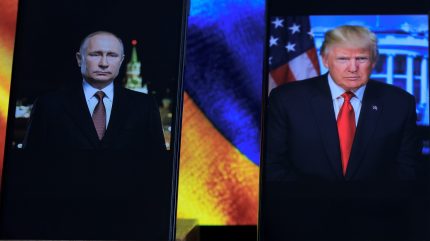
Three years into large-scale hostilities of the Ukraine-Russia conflict and with a new US administration up-ending Nato’s support of its ally, the prospect of a peace deal enforced by Washington and Moscow could well see the war’s fourth year turn in a direction few expected.
Both Ukraine and Europe have been frozen out of US-Russian negotiations. US President Donald Trump has lambasted Washington’s former ally Ukraine, calling its President Volodymyr Zelenskyy a “dictator”, in an icy blast of irony that could have come from any number of mouthpieces owned by Russian President Vladimir Putin.
Europe has also not been spared, with US Defense Secretary Pete Hegseth moving one foot of the US out of Nato itself, stating that Europeans would have to look to their own ends for “conventional security”.
Does this mean the US would not respond to an Article 5 invocation by European ‘allies’ in the event of a conventional-only attack on their territory by Russia? Should this be the case, then Nato is dead in the water.
Europe tries to talk the walk
Meanwhile, tough talk is in vogue as European leaders attempt to find a place for themselves in an emerging world order of strongman politics.
Although UK Prime Minister Kier Starmer has said he would commit UK military forces into Ukraine for any peacekeeping requirement, his European allies have been less than forthcoming, despite persistent protestations of solidarity with Kyiv.

US Tariffs are shifting - will you react or anticipate?
Don’t let policy changes catch you off guard. Stay proactive with real-time data and expert analysis.
By GlobalDataStarmer heads to Washington this week presumably to plead for just this, but he will come up against a US President that instinctively does not want US forces protecting anything other than the homeland and positioning against the rising threat of China. Given this, Starmer will likely fail.
Potentially, a European ‘peacekeeping enforcement’ structure could see combat air power positioned in the countries bordering Ukraine, such as Poland and Romania, with the ability to rapidly respond to any breaches by Russian forces.
But this requires a ceasefire in the first place, something that Putin knows he does not have to accede to, given the cessation of US support to Kyiv. Within six months, that front-loading of military equipment and aid pledged in the final days of the Biden administration will have run its course.
Europe would then have to pick up the slack – some 25% of military equipment given to Ukraine has come from the United States. This portion has been described as the “cream” of the military capabilities provided to Kyiv, including capabilities such as the HIMARS launchers and the ATACMS short range ballistic missiles.
The US could also deny Europe permission to allow Ukraine to use European military equipment that has US components inside, including key long-range missiles. What prospect continued delivery of US origin F-16 fighters to Kyiv?
European economies are broke and exhausted, wracked by the spectres of inflation, mini recessions, and political instability. Its populations question the continued provision of billion of euros and pounds in aid to Ukraine as the cost of living crisis is turning families into a hand-to-mouth existence.
Patience: the key to defeating Washington
The US also has a virtual monopoly over Nato’s command and control structure as well, with the position of Supreme Allied Commander Europe (SACEUR) always held by the United States.
The US has the space-based surveillance, ISR, and C2 networks needed to monitor and organise any peacekeeping mission, be it based inside or outside of Ukrainian territory.
Even if Europe were to undertake the C2 elements itself, how would decisions be made? Consensus, or would a singular country take a revolving leadership role as with the European Union presidency? Might the UK/French Combined Joint Expeditionary Force framework offer a potential solution?
As with the Taliban in Afghanistan, Russia has simply needed to have patience and wait for Washington to decide it wants to do something different.
The only glimmer of hope may lie in President Trump’s desire for a deal, this time on Ukraine’s rare earth minerals in exchange for continued US support, with Washington seeking new ways to obtain stocks after having been frozen out of China’s supply.



